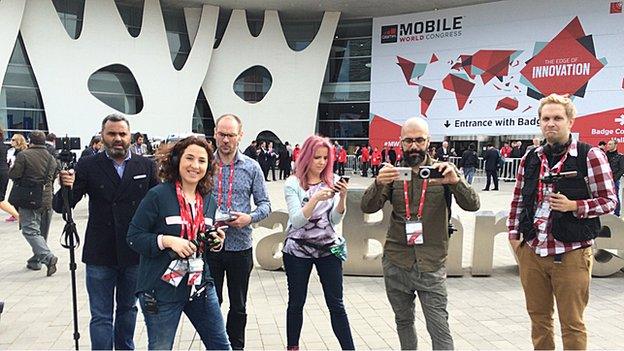Technology TV programme Click made on mobiles
- Published

We are coming to the end of a very stressful week, filming and editing an episode of Click on mobiles. As in, the programme is about mobiles.
We have been to the massive Mobile World Congress, external in Barcelona. But we are also filming, and editing it, just using mobiles.
We think this is the first time professional television has attempted this, especially since we are using a wide range of devices, and not just sticking to one type of phone.
And it is going hideously.
To be honest, I think we need a medal for ambition.
Filming and editing a programme in five days is hard enough anyway, but to do it without the proper tools for the job is the idea of a maniac. And his name is Simon Hancock. He may or may not still be our boss by the time you read this.

Filming on mobiles proved challenging
That said, filming the programme went a lot better than we had expected.
Despite being armed with a million gigabytes (GB) of micro SD cards (source: Spencer's imagination) and enough power chargers to light up Spain, our phones shot great video, did not run out of power or storage, and most of the sound was useable.
The research began weeks ago, when our producer Talia Franco started testing phones, apps, attachments, cables, splitters in order to work out how to get the best quality footage out of a phone.
Even though all smartphones record HD nowadays, the quality of the video varies greatly.
This is not only due to the varying quality of optics on each device but it is also to do with the compression the camera app uses to save the video. After all most footage filmed on a smartphone never sees a big screen, so who cares?
This where apps like Filmicpro on the iPhone and Cinema-FV5 on Android come in to play.
Both apps let you delve deep into the settings and tinker with almost everything, including the amount the video is compressed.
Here Filmicpro had a clear advantage, the makers of the app only had to cater for one gadget, namely the iPhone.
Cinema-FV5 for Android has to work on many devices from a multitude of manufacturers so we found some features were locked on some devices.
WATCH: Click's Spencer Kelly explains how they filmed the programme on mobile phones
The other problem with mobile phone footage is it tends to be a tad wobbly, basically because phones are difficult to hold steady.
Enter the Lanparte three-axis gimbal, quite possibly the real star of the shoot. This handheld beauty kept our phonecams level, smooth and steady as our camera operators fought their way through the crowds of the show.
You may have noticed that on TV we like to talk a lot - painting pictures with sound, you know.
The smartphones' internal microphones were no good whatsoever for this. And even the market leading Rode smartLav+ clip-on microphone did not give us great quality sound. So we opted for a Pro-Jive splitter cable allowing us to plug our existing professional radio microphones into the phones.
Using this cable meant we could get our voices into the devices and our headphones at the same time.
Mind you, only one phone, the iPhone, allowed us to actually hear the sound as it was being recorded.
All others would cut the headphone feed as soon as you push the big red button. The result was occasionally distorted but mostly usable sound.
And unlike our pro cameras, the mobile phones could only shoot a wide angle shot, which is great for general filming but not so great for getting close up, detailed images.
Our Olloclip lens clips for the iPhone and the Samsung meant we could come a step closer to imitating our professional gear.
Spirits were up. Confidence was high. But then it all went south.
Freezing and crashing
Editing. That thing you normally do on a massive desktop machine with RAM, RAM and more RAM. Or at least on a beast of a laptop.

The tablet struggled with the demands of editing
In order to stay within the spirit of our project, we opted to edit on tablets.
Pinnacle on the iPad was pretty nice to use, intuitive and easy, until you dared try and use any footage not shot on an iPhone or iPad.
At this point it would refuse to play the video, fold its arms and cry in the corner. We used it for editing short pieces only. Then we sent it for some therapy.
The only way we could edit something as complicated as a 23 minute programme with video from nine or 10 different cameras encoded with nine or 10 different codecs, was to use Adobe Premiere Pro on a Surface Pro 3.
But these machines simply do not have the processing power to cope with the incredible burden. Even when they are not crashing, freezing and juddering, they are not keeping up with the editors' keypresses.
It is getting late, my dinner's cold and my son is already asleep, and still we edit into the night.
I will dream of spinning circles, blank screens, and lost media.
Wish us luck, dear reader, and if we do not make the deadline, I hope you enjoy the repeat of Top Gear.
You can follow Spencer @spenley, external and follow Click at @BBCClick , external